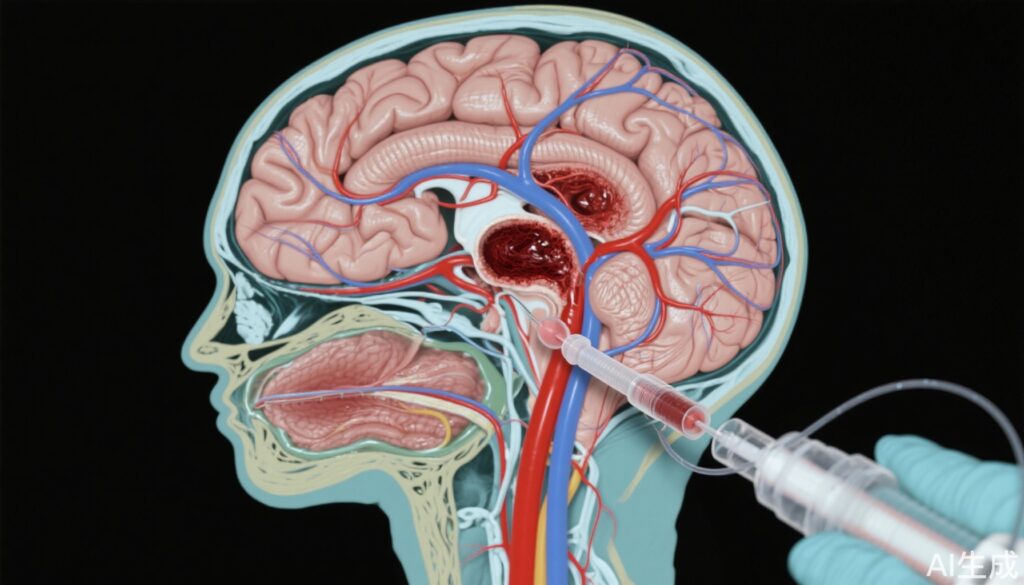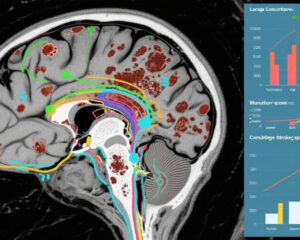Highlight
1. Endovascular therapy (EVT) offers a significant shift towards improved 1-year functional outcomes in patients with large ischemic cores compared to standard medical management (MM).
2. Functional independence (mRS 0-2) at one year doubled from 17.1% in the MM group to 30.4% in the EVT group.
3. Despite higher mortality in the EVT group at 1 year (31.3% vs. 26.5%), mortality differences were not statistically significant.
4. The benefit of EVT over MM in functional outcomes persists at one year, with a narrowing treatment effect between 90 days and 1 year due to functional gains in MM patients.
Study Background and Disease Burden
Stroke remains a leading cause of disability and death worldwide, with large ischemic core strokes carrying particularly poor prognoses. Endovascular therapy (EVT) has become a standard of care for acute ischemic strokes due to large vessel occlusions. While multiple trials have established EVT’s safety and efficacy in reducing disability at 90 days post-stroke, questions remain about the long-term outcomes, particularly among Asian populations who may have distinct stroke pathophysiology and treatment responses. Large ischemic core patients often face greater risks and poorer outcomes, posing a substantial burden on healthcare systems and quality of life. The ANGEL-ASPECT trial was designed to assess the durability and extent of EVT benefits against medical management (MM) over a 1-year period in this high-risk group.
Study Design
The ANGEL-ASPECT trial was a phase 3, randomized, open-label, blinded endpoint assessment study conducted across 46 hospitals in China. Eligible patients presented with large anterior circulation vessel occlusion and exhibited either an Alberta Stroke Program Early CT Score (ASPECTS) between 3 and 5 or a large infarct core volume of 70 to 100 mL. Participants were randomized in a 1:1 ratio to receive either EVT or standard medical management. The primary endpoint was the functional outcome at 1 year, measured by distribution shift in modified Rankin Scale (mRS) scores (0 indicating no symptoms; 6, death). Secondary endpoints included functional independence (mRS 0-2), independent ambulation (mRS 0-3), and mortality. The trial registration number is NCT04551664.
Key Findings
Data from 425 patients (214 EVT, 211 MM) were analyzed at 1-year follow-up. The mean patient age was 66 years with a female representation of 38.1%. Compared to the MM group, the EVT group showed significantly better mRS outcomes, with a generalized odds ratio of 1.25 (95% CI, 1.01-1.56; P=0.04) indicating improved distribution toward less disability.
Functional independence (mRS 0-2) was achieved in 30.4% of EVT patients versus 17.1% in MM (relative risk [RR], 1.87; 95% CI, 1.27-2.75), and independent ambulation (mRS 0-3) was attained by 50.0% vs 35.6% (RR, 1.46; 95% CI, 1.15-1.85). Mortality at 1 year was 31.3% in the EVT group and 26.5% in the MM group, a non-significant difference (RR, 1.12; 95% CI, 0.82-1.53).
Longitudinally, functional independence rates remained stable from 90 days to 1 year in EVT subjects (29.4% vs. 30.4%), whereas MM patients showed notable functional gains in this period (10.9% to 17.1%), which narrowed but did not eliminate the relative benefit of EVT.
Expert Commentary
The ANGEL-ASPECT trial provides rigorous evidence supporting the long-term efficacy of EVT in patients with large ischemic strokes, confirming durable improvements in disability beyond the immediate 90-day period. Although mortality differences were not significant, the functional benefits are compelling and clinically meaningful, especially as functional independence correlates with quality of life and healthcare resource utilization.
The observed functional gains in the MM group over time highlight stroke recovery’s dynamic nature but do not undermine EVT’s superior effectiveness. These results reinforce evolving clinical guidelines advocating for EVT in large core strokes within extended treatment windows, particularly in Asian populations often underrepresented in prior studies.
Limitations include the open-label design and study restricted to Chinese hospitals, which may affect generalizability. Further research is warranted to refine patient selection and explore adjunctive therapies to reduce mortality.
Conclusion
For patients presenting within 24 hours with large ischemic strokes due to proximal anterior circulation occlusions, EVT significantly reduces long-term disability compared with medical management alone. The ANGEL-ASPECT trial’s 1-year data strengthen the evidence base favoring EVT as a durable treatment that improves functional outcomes in a high-risk population.
References
Huo X, Sun D, Nguyen TN, Ma G, et al; ANGEL-ASPECT Investigators. Endovascular Therapy Versus Medical Management for Large Ischemic Infarct: 1-Year Outcomes of the ANGEL-ASPECT Trial. Stroke. 2025 Sep;56(9):2398-2407. doi:10.1161/STROKEAHA.124.050086. Epub 2025 Aug 25. PMID: 40854041.



